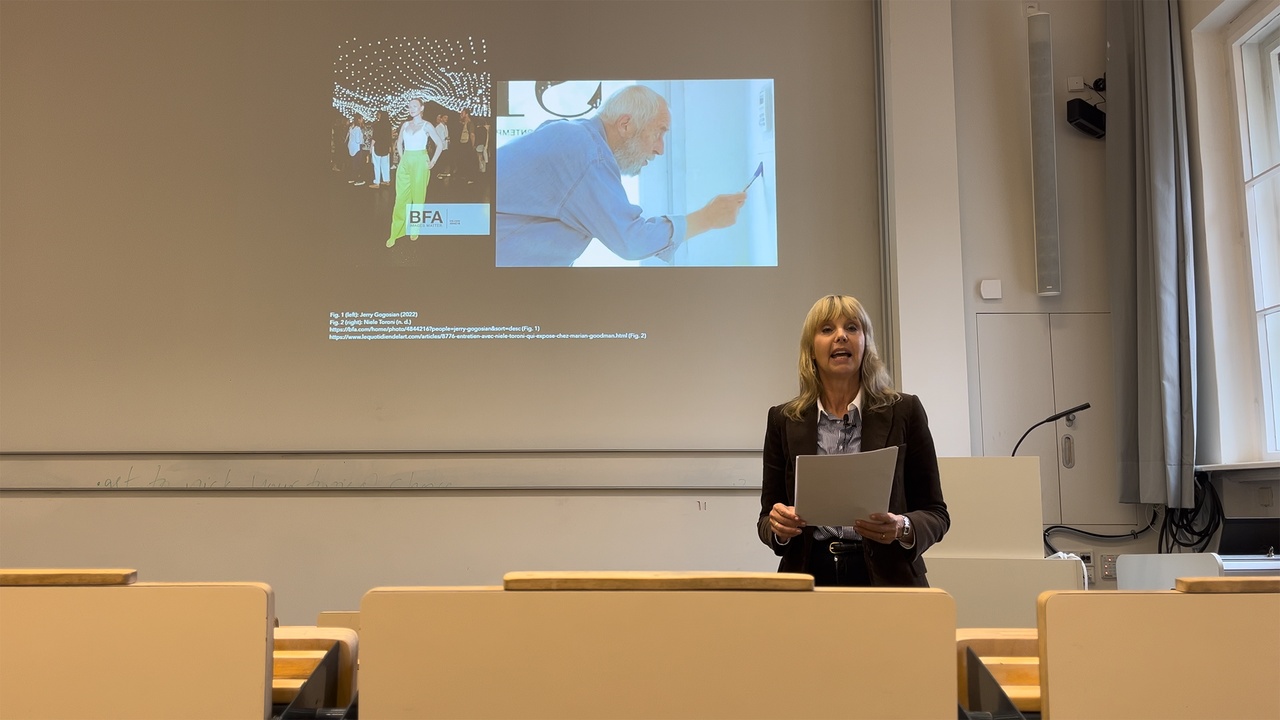RECORD AND REFLECT A Questionnaire on (Video) Lectures by Isabelle Graw

Isabelle Graw, „Time for a Reset“
QUESTION: You were free to choose the topic of your contribution. What did you decide on in connection with the theme of this issue and why?
ANSWER: I decided to start my contribution for the “Lecture” issue by pointing to Niele Toroni’s legendary three-part exhibition that took place at Yvon Lambert Gallery in Paris in 1970. What makes this exhibition quite remarkable is that it was announced anonymously. Without the artist’s name on the invitation cards, the emphasis was put on Toroni’s paintings. Omitting his name, the artist furthermore suggested that someone else could have produced the work. I argue that such a project was only possible as part of a then still intact “dealer-critic” system (Harrison White). In the current art industry, reigned by tech corporations, this would be unthinkable. Toroni’s anonymous show undercut what is most crucial for the artwork’s market value – the fact that it can be traced back to a singular author and thus prove its uniqueness. It is indeed difficult to imagine a contemporary dealer who would agree to show an artist anonymously nowadays. In methodological terms, I opted for a historical perspective that allows for an understanding of the extent of the current changes. But at the same time, I take contemporary phenomena, such as the Instagram posts of @jerrygogosian, which I consider symptomatic of the actual state of the art industry, into account. And since both Toroni’s practice and Gogosian’s posts depend on artists performing themselves – albeit quite differently – I also use my assessment of the performative dimension of their practice as an occasion to reflect on my own performance in this lecture.
Q: This issue makes a distinction between lecture and lecture performance. Do you? Where and how do you draw the line?
A: For me, every lecture is also a performance, but a “lecture performance” is by definition “artistic” and thus doesn’t claim to produce scientific truth in the same way that art historians do in their lectures.
Q: What specific forms of knowledge do academic or artistic lecture formats offer?
A: Academic lectures can provide a wide range of knowledge, but what is crucial is how this knowledge gets mediated. For me, the question of mediating knowledge is as important as producing it. The form the lecturer chooses for their topic matters a lot to me.
Q: Which aspects of embodiment are important to you when giving a lecture/performance?
A: When I give a lecture, I tend to acknowledge the presence of my audience, for instance, by looking at them while speaking. I also aim to signal via my body language that I am aware of the “authoritative” role I perform as a lecturer, one which I both take up and question at the same time. My intention is thus to avoid monological presentations and encourage the audience to enter into a controversial discussion with me.
Q: How do you find your rhythm?
A: I used to take singing lessons as a young woman, so in my mind, lecturing is all about breathing, punctuation, breaks, and sound. I tend to consider the manuscript as a songbook that has to be recited convincingly. The more melodic my rendering, the better.
Q: Where is your focus during the lecture/performance?
A: I look at those faces in the audience that seem to turn toward me in a friendly way. My focus is also on the main propositions of my lecture, which I try to bring across convincingly.
Q: What motivates you to attend a lecture/performance in person, given the constant surplus of information and art and the shortage of time that characterize our everyday lives?
A: If I’m interested in the work of the person who lectures, I’ll try to attend, because there’s a lot to learn from other people’s lectures – even what not to do in a lecture.
Q: Which lecture/performance was particularly memorable for you and why? (If the answer is Robert Morris’s 21.3 from 1964, please give another example.)
A: Jacques Derrida once gave a lecture in the Bibliothèque nationale in Paris. I will never forget him starting by saying, “Je sens votre presence” (I feel your presence). With this acknowledgment of people’s presence, he created an incredible tension in the room. Everyone felt included. The result was a sense of heightened emotion mixed with eager anticipation.
Q: Who was your (real or imagined) audience when you recorded this video lecture?
A: You all: Antonia, Anna, and Leonie, the editors of TEXTE ZUR KUNST.
Q: What shoes were you wearing?
A: Cowboy boots.
Isabelle Graw is the cofounder and publisher of TEXTE ZUR KUNST and teaches art history and theory at the Hochschule für Bildende Künste – Städelschule in Frankfurt am Main. Her most recent publications include In Another World: Notes, 2014–2017 (Sternberg Press, 2020); Three Cases of Value Reflection: Ponge, Whitten, Banksy (Sternberg Press, 2021); On the Benefits of Friendship (Sternberg Press, 2023); and the forthcoming Fear and Money. A Novel (Sternberg/MIT Press, 2025).

